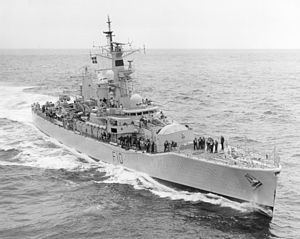Cost £4.65m Laid down 1 June 1961 Construction started 1 June 1961 Length 113 m Beam 13 m | Yard number 721 Commissioned 9 April 1964 Launched 28 November 1962 Draft 4.5 m Builder John Brown & Company | |
 | ||
HMS Aurora (F10) was a Leander-class frigate of the Royal Navy (RN). Like other ships of the class, Aurora was named after a figure of mythology, Aurora being the Roman equivalent of the Greek goddess Eos.
Contents
History
HMS Aurora was built by John Brown & Company, shipbuilders of Clydebank, Scotland. Aurora was launched on 28 November 1962 and commissioned on 9 April 1964.
Aurora became the leader of the 2nd Frigate Squadron in 1964. On 17 April 1968, her Westland Wasp ASW helicopter from 829 Naval Air Squadron (s/n XS540, No. 455) crashed off South Africa. It was replaced by an aircraft (No. 444) from HMS Gurkha (F122). In 1972, during the Second Cod War, Aurora came to the aid of an Icelandic fishing vessel that had caught fire, rescuing its crew in the process. Soon after this incident, Aurora underwent modernisation which included the addition of the Ikara anti-submarine warfare (ASW) missile launcher that in effect changed the Batch One ships, of which Aurora was part, into a specialised ASW batch rather than its original role as a general-purpose batch. The modernisation was completed in 1976.
In 1978, Aurora joined the Fishery Protection Squadron, undertaking patrols and other duties in support of British fishing interests around the UK. She remained with the squadron until she was eventually transferred to the 7th Frigate Squadron, which was stationed in the Far East, just as the RN's presence in that region was steadily dwindling. Further duties were undertaken by Aurora across the world, but in 1987, due to defence cuts, as well as manpower shortages, a common problem for the RN at that time, Aurora was decommissioned.
